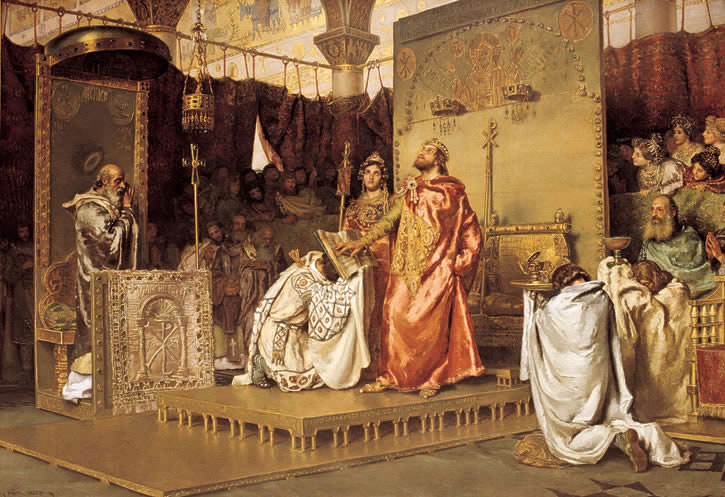 |
| Visigoth Kingdom of Spain |
The earliest Visigoths were a Germanic group that alternated between opposing and serving the Roman Empire. Unlike some other Germanic tribes, the Visigoths retained elected leaders, never shifting to a fully hereditary kingship. The early Visigoths, like other Germanic peoples in the late Roman and early post-Roman periods, were Arian Christians—believing that the Son, Christ, had been created by the Father rather than being coeternal, as the Catholic Church believed.
This meant that Visigothic kings could not be fully sure of the loyalty of the Catholic Church in their dominions, although they did not attempt to destroy the church or extirpate Catholicism.
After the famous sack of Rome by the Visigothic king Alaric in 410 c.e., the Visigoths settled in southern France, from which they first spread into the Iberian Peninsula in 416, as allies of the Roman emperor Honorius. The Roman government was trying to regain control of the province, then in the hands of a barbarian coalition. The Visigoths returned to Spain, this time permanently, under their King Theodoric II in 456.
  |
The most significant king of this phase of Visigothic history was Euric, who reigned from 466 to 484, under whom the Visigothic kingdom, with its capital at Toulouse, reached its greatest geographical extent, incorporating most of Iberia. Euric eliminated the last areas of direct Roman rule in Spain following the collapse of the Western Roman Empire in 476.
The Visigothic kingdom was based in Spain after 507, when the Visigoths were defeated and the Catholic Franks under Clovis killed their king, Alaric II. In alliance with the Burgundians, the Franks drove the Visigoths out of nearly all their possessions in France.
The sole remainder of the French Visigothic kingdom was Septimania, between the Pyrenees and the lower Rhone. The Visigoths also lost some coastal territories in southern Spain to the Byzantines under the Emperor Justinian I.
The most important rulers in sixth-century Visigothic Spain were Leovigild, who reigned 568–586, and his son Reccared, who reigned 586–601. Leovigild reinvigorated the Visigothic monarchy, defeated the Suevi kingdom of northwestern Spain and incorporated it into the Visigothic kingdom, and drove the Byzantines from all but a few small footholds in the south.
He also established a permanent capital at Toledo— previously, Visigothic rulers had traveled through the peninsula rather than having a permanent base. Leovigild was also a lawgiver, promulgating extensive revisions of the earlier code of King Euric.
In 587 Reccared solved the problem of the kingdom’s religious divisions by converting to Catholic, Trinitarian Christianity, the religion of nearly all of his non-Visigothic subjects, as well as a growing number of Visigoths.
He extended this conversion to his kingdom in the Third Council of Toledo in 589. At this council Reccared, his family, and other leaders of the kingdom formally renounced Arianism before the Catholic bishops.
The new regime was intolerant toward Arians, and Recarred crushed a series of rebellions led by Arian clergy and believers. The removal of the religious divisions between the Visigoths and the Roman elite led to greater assimilation between the two groups.
The seventh-century Visigothic monarchy was marked by strong cooperation between church and state, with the king making ecclesiastical as well as civil and military appointments, building churches, and working closely with the bishops.
The Catholic Church in Spain, although in communion with Rome, was more subject to the king than to the pope. The Visigothic kingdom was also one of the more peaceful and prosperous areas of the post-Roman West, retaining its links to the Mediterranean economy and a relatively high degree of urbanization.
One way in which the strongly sacral nature of Catholic Visigothic kingship was expressed was a series of decrees against the Jews. The Catholic Visigothic kings were an exception to the generally tolerant practices of Germanic barbarian kings toward the Jews in the early Middle Ages.
King Sisebut (r. 612–621) ordered that Jews be forcibly baptized or exiled from the kingdom. Sisebut was one of the most learned early medieval kings, writing in Latin the Life of St. Desiderius and a poem on eclipses. Legislation was an important component of Visigothic kingship.
The legal decrees and codes issued by the Visigothic rulers show a progression away from different laws for Visigothic and Roman subjects, toward a single code of law for all peoples in the kingdom. This process of assimilation culminated in the Laws of the Visigoths, issued in 654 by King Recceswinth.
Recceswinth, following the path laid out by his father, King Chindaswinth, abolished previous codes of Visigothic and Roman law in favor of a law applying uniformly over Visigothic territory and drawing from both Germanic and Roman sources.
The Laws of the Visigoths, revised again by King Erwig in 681, was the most detailed and sophisticated law code of the early post-Roman kingdoms. The Laws of the Visigoths continued to influence law in Christian Spain long after the fall of the Visigothic kingdom.
Late seventh-century Visigothic kings, although supported by the church, suffered disputed successions, rebellions, and problems with the nobility. A dispute weakened the kingdom before the Arab invasion in 711.
The Arabs also benefited from the Visigothic rulers’ alienation of the Jewish population, who welcomed the Muslim invaders as liberators. The Arabs killed the last Visigothic ruler, King Rodrigo, or Roderic, and the Visigothic kingdom and ethnic identity came to an end.




